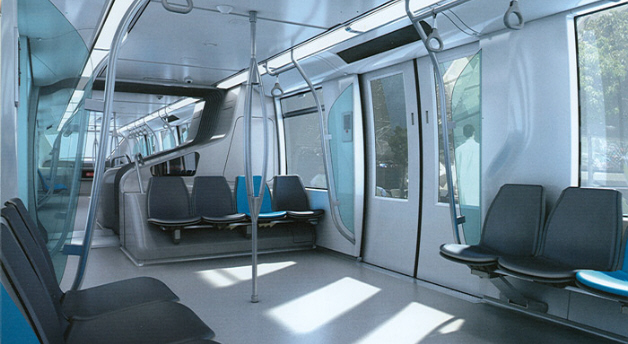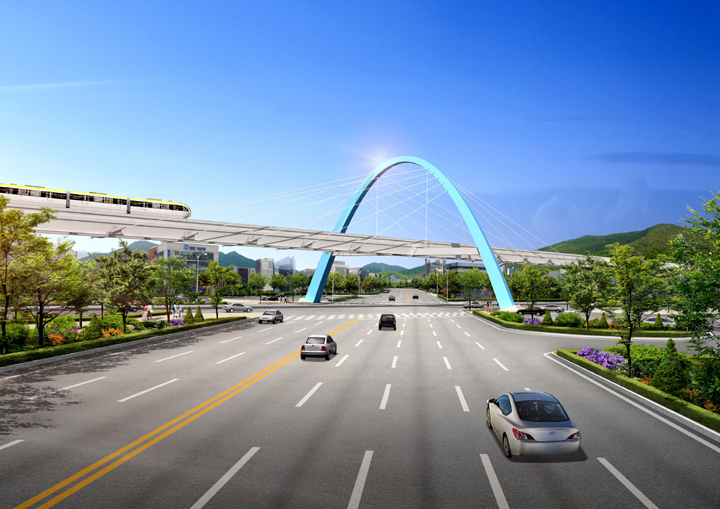Concept
A high-capacity automated monorail to Melbourne Airport from Southern Cross Station as part of the Melbourne Skyrail proposal.
 Bombardier Innovia 300 - one of several monorail train options. (Bombardier Transportation) |
- 22 hour a day operation: As the monorail can be automated operation 22 hours per day is affordable. This is useful as the airport runs almost 7*24.
- Eight-carriage trains every three minutes: Providing the long-awaited high-capacity public transport link to Melbourne Airport from the Melbourne CBD.
- Beats the Bus: Increasingly the Skybus is getting stuck in the traffic in peak times with journeys taking 30 minutes or more.
- Beats the Melbourne Airport Rail Link: A high capacity monorail is a more cost-effective option than the proposed Melbourne Airport Rail Link (MARL) which we discuss below.
Four Options!
Over time Monorails Australia has suggested several options for this key route. Peter O'Brien's "Airshuttle" proposal is also listed here for comparison.
- Airshuttle Australia Proposal: Peter O'Brien's Airshuttle Australia has the funding lined up to build an express monorail from Melbourne CBD to the airport. This would largely be built over city link.
- Latest Monorails Australia Proposal: Our latest version of this proposal is here (PDF). This proposal suggests using the Milliera - Military Road route with multiple stations along the way including High Point Shopping Centre. (See Melbourne West page.)
- Moonee Ponds Route: this is described below.
- Maglev High Speed Link: An alternative high speed maglev link to Melbourne Airport is proposed here. This alternative could form the Melbourne-end of a high speed Melbourne-Sydney maglev link.)
Cost
Our current cost range estimate is about $1,000 million for a conventional monorail with all components. This estimate is to be further refined by ongoing analysis.
Resident Benefits
Home-owners near the monorail line receive the following benefits depending on their proximity to the monorail track:
- Removal of overhead power and other wires which are to be relocated underground.
- A daily payment during construction of the monorail outside their properties.
- A monthly payment for the life of the monorail system related to ticket sales for residential property within 20 meters of the track. This is anticipated to be between a few hundred and a few thousand dollars per annum depending on proximity to the track.
- A vegetated tree-way under the monorail track and extra trees along the sides of the street where possible.
- Extra public transport in their area.
Approximate Route
The approximate route of the proposed Melbourne Airport Monorail is shown below. Click into the map to zoom in on particular segments.
|
View Melbourne Airport Monorail in a larger map Approximate route of the Melbourne Airport Monorail |
The alternative is to run the monorail via Highpoint shopping centre. Including this major destination may make this route more economic.
Destinations and Connections
This is essentially an express service to the airport with minimal stops to link to other transit systems.
- Southern Cross Station: The monorail platforms would be near the Direct Factory Outlet (DFO) complex giving good access to all V/Line and Metro services at Southern Cross Station as well as the proposed Doncaster and Highpoint and Chadstone Monorail monorail lines. Trains from the Airport continue to Chadstone.
- Moonee Ponds Station: The monorail platforms could be placed near the existing station with good access to the Puckle Street shops.
- Niddrie Station: This provides a connection to the No. 59 tram that runs up to Essendon Airport. It is proposed that the retail premises shown here would be redeveloped with the monorail station on top. Other sites in this area could also be redeveloped to create a more vibrant activity centre.
- Melbourne Airport: Melbourne Airport with lifts and escalators down to arrival and departure levels. The guide way may continue to stabling and maintenance yards to the east of the airport.
 Monorails can span wide areas if required. Trains of up to eight carriages can be used. (Daegu Monorail, South Korea. Daegu Blog) |
Travel Times
The high-capacity monorails under consideration have a maximum operating speed of 80 km/h. Assuming 10-second dwell times* at the stations the following travel times are likely:
- Southern Cross - Melbourne Airport: About 20 minutes.
- Southern Cross - Moonee Ponds: About 8 minutes.
- Moonee Ponds - Melbourne Airport: About 12 minutes.
(*Similar to dwell time for trains and flat-floor trams.)
Capacity
Monorail capacity is discussed here. An eight-carriage monorail trains could transport over 15,000 passengers per hour per direction. A two-carriage train could easily transport 10 million passengers per annum and then be expanded as required.
Possible Extensions
- Extension South: At the Southern cross end the monorail this monorail could join to the line going to Chadstone.
- Extension West: From the airport the monorail could extend west to join the Broadmeadows and Upfield lines.
Melbourne Airport Rail Link (MARL)
For many years different heavy rail links to Melbourne Airport have been considered but the prohibitive cost of an effective heavy rail link and successive government's focus on road building has prevented any such link being started.
|
MARL Alternative Routes. Dashed routes are underground. 2012 PTV MARL Study (PDF)) |
Stumbling blocks for MARL
- Cost: All of the options that provide reasonable transit time to the airport are prohibitively expensive. Neither Liberal or Labor has made any funding commitment to MARL. Both the dashed tunnel routes above are extremely expensive.
- Rail congestion: All the rail options require major work to be done on the heavy rail network, especially at the CBD end. Currently the government claims nothing can be done until the Melbourne Metro is built.
- Poor Service Frequency: Most of the rail options require large sections of the track to be shared which limits service frequency to 10 minutes.
- Long Travel Times: The target travel time is 30 minutes. Trains take 43 minutes from the CBD to Coolaroo now so presumably an airport train would take an hour via that route. Due to existing congestion the East Albion route will also be slower than the bus is now.
Monorail advantages
The monorail option has several advantages over the rail options:
- Monorails are cheap. Several monorail lines could be built to the airport for the price of one heavy rail link.
- The monorail option does not interfere with rail operations and runs directly into the CBD.
- The monorail can be more easily be extended north or south than a rail subway.
Other Option
A Maglev Monorail to the airport which could later form part of a Melbourne-Sydney maglev system. Our Airport Maglev proposal is here: Melbourne airport maglev proposal.